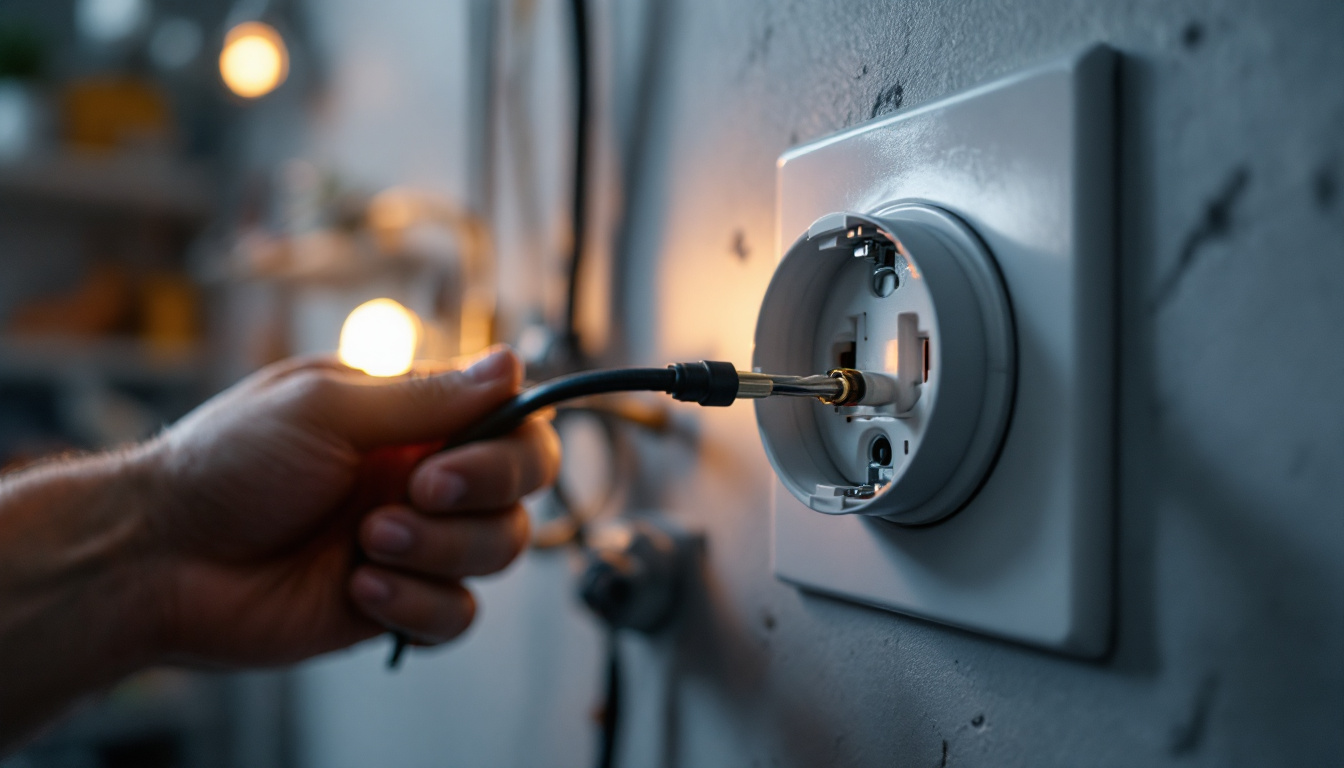
In the realm of electrical installations, lighting contractors often focus on the aesthetics and functionality of lighting fixtures. However, one critical aspect that frequently gets overlooked is the dryer power outlet. This seemingly mundane component plays a significant role in the overall electrical system of a home or commercial space. Understanding its importance can enhance the quality of work and ensure safety.
Dryer power outlets are designed to handle high voltage and current, typically 240 volts, which is essential for operating electric dryers efficiently. Neglecting to consider these outlets during installation can lead to various issues, including electrical hazards, inefficient appliance operation, and potential code violations.
One of the most common misconceptions among lighting contractors is that dryer outlets are just another plug. In reality, these outlets require specific wiring and circuit considerations. Many contractors may assume that any outlet can serve as a dryer outlet, leading to improper installations that can jeopardize safety.
Furthermore, some contractors may overlook the need for dedicated circuits for dryers. Sharing circuits with other appliances can result in overloads, causing breakers to trip or, worse, creating fire hazards. Understanding the unique requirements of dryer outlets is crucial for ensuring a safe and efficient electrical system.
In addition to the technical specifications, it’s important to recognize the role of dryer power outlets in enhancing the longevity of the appliances they serve. Electric dryers, when connected to the appropriate outlet, operate at optimal efficiency, reducing wear and tear on internal components. This not only prolongs the life of the dryer but also minimizes the risk of costly repairs or replacements down the line. Moreover, ensuring that the outlet is properly grounded and installed according to local codes can prevent electrical surges that might otherwise damage the appliance.
Another aspect to consider is the growing trend of energy-efficient appliances. As manufacturers develop dryers that consume less energy while maintaining performance, the importance of a properly installed power outlet becomes even more pronounced. These modern dryers often come with specific power requirements that must be met to function effectively. Lighting contractors who stay informed about these advancements can provide better service to their clients, ensuring that installations meet both current standards and the evolving needs of energy-efficient technology.
Adhering to electrical codes and safety standards is paramount for any lighting contractor. The National Electrical Code (NEC) outlines specific requirements for dryer power outlets, including the type of wiring, outlet configuration, and circuit specifications. Failing to comply with these codes can lead to severe consequences, including fines, liability issues, and increased risk of electrical fires. In addition to the NEC, local building codes may impose additional requirements that contractors must be aware of, further emphasizing the importance of staying updated on both national and local regulations.
For instance, the NEC mandates that a dryer outlet must be rated for 30 amps and connected to a dedicated circuit. This is to ensure that the outlet can handle the load without overheating or causing other electrical issues. Lighting contractors must familiarize themselves with these regulations to avoid costly mistakes and ensure the safety of their installations. Regular training and certification can be beneficial for contractors, as these programs often cover the latest updates in electrical codes and safety practices, helping to maintain high standards in their work.
When it comes to wiring dryer outlets, contractors must use the appropriate gauge wire. Typically, a 10-gauge wire is required for a 30-amp circuit. Using a lower gauge wire can lead to overheating and pose a fire risk. Additionally, the wiring must be installed correctly to prevent loose connections, which can also lead to dangerous situations. It is also essential to consider the length of the wire run, as longer distances may require a larger gauge to ensure that voltage drop does not compromise the performance of the dryer.
Moreover, grounding is a critical aspect that should never be overlooked. Proper grounding helps protect against electrical shocks and ensures the safe operation of the dryer. Lighting contractors must ensure that the outlet is grounded according to code requirements, which may involve using a three-prong outlet or a four-prong outlet depending on the age of the home and local codes. In older homes, it may be necessary to upgrade the electrical system to accommodate modern appliances safely. This can include installing new circuits, updating the panel, or even rewiring sections of the home to ensure compliance with current safety standards. Understanding these nuances not only enhances the safety of the installation but also adds value to the property by ensuring that it meets modern electrical standards.
proper installation of dryer power outlets is essential for both safety and functionality. Lighting contractors should follow best practices to ensure that the outlets are installed correctly and can handle the demands of modern dryers.
One of the first steps in the installation process is to determine the appropriate location for the outlet. It should be easily accessible while also considering the layout of the laundry area. This ensures that the dryer can be connected without strain on the cord, which can lead to wear and tear over time.
There are different types of dryer outlets available, including three-prong and four-prong configurations. The choice between these outlets often depends on local codes and the age of the dryer. Older dryers typically use three-prong outlets, while newer models require four-prong outlets for enhanced safety.
Contractors must assess the specific needs of the installation and choose the appropriate outlet type accordingly. This decision not only affects safety but also the overall functionality of the dryer. Ensuring compatibility with the dryer model is essential to avoid potential issues down the line.
Once the dryer outlet is installed, it is crucial to conduct thorough testing to ensure everything is functioning correctly. This includes verifying the voltage and current to ensure they meet the required specifications. A multimeter can be used to check for proper voltage levels and to ensure that the outlet is grounded correctly.
Additionally, contractors should check for any signs of overheating or loose connections during the testing phase. Addressing these issues before the installation is complete can save time and money in the long run, as well as enhance the safety of the electrical system.
Even experienced lighting contractors can make mistakes when it comes to dryer power outlets. Being aware of common pitfalls can help avoid costly errors and ensure a successful installation.
One of the most significant mistakes is underestimating the power requirements of modern dryers. Many contractors may not realize that newer models often require more power than older ones. This can lead to inadequate wiring or circuit configurations that cannot support the dryer’s needs.
Another common mistake is ignoring local codes and regulations. While the NEC provides a national standard, local jurisdictions may have additional requirements. Failing to adhere to these codes can result in fines and the need to redo the work, leading to delays and increased costs.
Contractors should always check local codes before beginning any installation. This diligence ensures compliance and enhances the safety and reliability of the installation.
Lighting contractors often focus on the immediate needs of a project but may neglect future considerations. For instance, as technology evolves, homeowners may upgrade their appliances, including dryers. Installing a dryer outlet that can accommodate future upgrades can save time and money in the long run.
Contractors should consider installing a four-prong outlet even if the current dryer only requires a three-prong outlet. This foresight can prevent the need for additional work in the future and ensure that the electrical system remains up to date.
Providing quality installations is not only about meeting technical specifications; it’s also about enhancing customer satisfaction. Understanding the importance of dryer power outlets can significantly impact the overall experience for clients.
By ensuring that dryer outlets are installed correctly and meet all safety standards, contractors can build trust with their clients. This trust can lead to repeat business and referrals, which are invaluable in the competitive field of electrical contracting.
In addition to providing quality installations, educating clients about the importance of dryer power outlets can further enhance satisfaction. Many homeowners may not understand the intricacies of electrical systems, and explaining the significance of proper installations can empower them to make informed decisions.
Contractors can take the opportunity to discuss the benefits of dedicated circuits, the importance of grounding, and the differences between outlet types. This not only builds trust but also positions the contractor as a knowledgeable expert in the field.
Dryer power outlets are a crucial component of any electrical installation, yet they are often overlooked by lighting contractors. Understanding their importance, adhering to code requirements, and following best practices can significantly enhance the quality and safety of electrical work.
By avoiding common mistakes and considering future needs, contractors can provide installations that not only meet current demands but also stand the test of time. Ultimately, prioritizing the proper installation of dryer power outlets can lead to increased customer satisfaction and a solid reputation in the industry.
In a field where safety and reliability are paramount, taking the time to understand and properly install dryer power outlets is a step that every lighting contractor should prioritize. Embracing this knowledge will not only enhance the quality of work but also contribute to a safer and more efficient electrical system.
As you prioritize the proper installation of dryer power outlets to enhance your electrical projects, remember that quality begins with the right materials. At LumenWholesale, we provide contractors with spec-grade lighting products that meet the highest industry standards. Our extensive selection is available at unbeatable wholesale prices, ensuring you get the best value for your investment. Say goodbye to local distributor markups and hello to hassle-free bulk buying with free shipping. Elevate your electrical installations with reliable, high-performance lighting by visiting Wholesale Lighting at the Best Value today.

Discover the vibrant world of colorful flood lights with our comprehensive guide tailored for lighting contractors.

Discover essential tips for lighting contractors on using outdoor string lights with white cords.

Discover how LED 4 shop lights are revolutionizing the way contractors illuminate their projects.

Discover the frequent pitfalls lighting contractors encounter with tubular lamp bulbs.